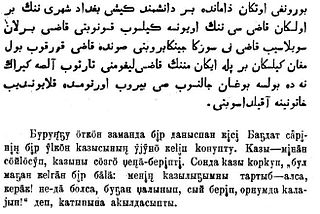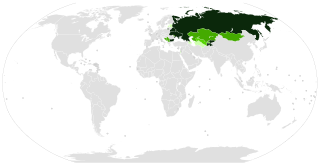Related Research Articles

Kabardian also known as East Circassian, is a Northwest Caucasian language closely related to the Adyghe language. Circassian nationalists reject the distinction between the two languages and refer to them both as "Circassian".
Three scripts are currently used for the Tatar language: Arabic, Cyrillic and Latin.
Altai is a set of Turkic languages spoken officially in the Altai Republic, Russia. The standard vocabulary is based on the Southern Altai language, though it's also taught to and used by speakers of the Northern Altai language as well. Gorno–Altai refers to a subgroup of languages in the Altai Mountains.The languages were called Oyrot (ойрот) prior to 1948.

Nogai also known as Noğay, Noghay, Nogay, or Nogai Tatar, is a Turkic language spoken in Southeastern European Russia, Kazakhstan, Uzbekistan, Ukraine, Bulgaria, Romania and Turkey. It is the ancestral language of the Nogais. As a member of the Kipchak branch, it is closely related to Kazakh, Karakalpak and Crimean Tatar. In 2014 the first Nogai novel was published, written in the Latin alphabet.

Karakalpak is a Turkic language spoken by Karakalpaks in Karakalpakstan. It is divided into two dialects, Northeastern Karakalpak and Southwestern Karakalpak. It developed alongside Nogai and neighbouring Kazakh languages, being markedly influenced by both. Typologically, Karakalpak belongs to the Kipchak branch of the Turkic languages, thus being closely related to and highly mutually intelligible with Kazakh and Nogai.
Shor is a critically endangered Turkic language spoken by about 2,800 people in a region called Mountain Shoriya, in the Kemerovo Province in Southwest Siberia, although the entire Shor population in this area is over 12000 people. Presently, not all ethnic Shors speak Shor and the language suffered a decline from the late 1930s to the early 1980s. During this period the Shor language was neither written nor taught in schools. However, since the 1980s and 1990s there has been a Shor language revival. The language is now taught at the Novokuznetsk branch of the Kemerovo State University.
The modern Gagauz alphabet is a 31-letter Latin-based alphabet modelled on the Turkish alphabet and Azerbaijani. It is used to write the Gagauz language.

Three alphabets are used to write Kazakh: the Cyrillic, Latin and Arabic scripts. The Cyrillic script is used in Kazakhstan and Mongolia. An October 2017 Presidential Decree in Kazakhstan ordered that the transition from Cyrillic to a Latin script be completed by 2031. The Arabic script is used in Saudi Arabia, Iran, Afghanistan, and parts of China.

Yaña imlâ was a modified variant of Arabic script that was in use for the Tatar language between 1920 and 1927. The orthographical reform modified İske imlâ, abolishing excess Arabic letters, adding letters for short vowels e, ı, ö, o. Yaña imlâ made use of "Arabic Letter Low Alef" ⟨ࢭ⟩ to indicate vowel harmony. Arguably, Yaña imlâ had as its goal the accommodation of the alphabet to the actual Tatar pronunciation.

The Uzbek language has been written in various scripts: Latin, Cyrillic and Arabic. The language traditionally used Arabic script, but the official Uzbek government under the Soviet Union started to use Cyrillic in 1940, which is when widespread literacy campaigns were initiated by the Soviet government across the Union. In Uzbekistan, the Latin script was officially reintroduced, along with Cyrillic, in 1992, and a full transition to Latin script is awaiting implementation. In neighboring Kyrgyzstan and Tajikistan, people use Cyrillic. In the Xinjiang region of China, some Uzbek speakers write using Cyrillic, others with an alphabet based on the Uyghur Arabic alphabet. Uzbeks of Afghanistan also write the language using Arabic script, and the Arabic Uzbek alphabet is taught at some schools in the country.

There are 4 stages in the history of Yakut writing systems:

Numerous Cyrillic alphabets are based on the Cyrillic script. The early Cyrillic alphabet was developed in the 9th century AD and replaced the earlier Glagolitic script developed by the theologians Cyril and Methodius. It is the basis of alphabets used in various languages, past and present, Slavic origin, and non-Slavic languages influenced by Russian. As of 2011, around 252 million people in Eurasia use it as the official alphabet for their national languages. About half of them are in Russia. Cyrillic is one of the most-used writing systems in the world. The creator is Saint Clement of Ohrid from the Preslav literary school in the First Bulgarian Empire.
The Cyrillic script family contains many specially treated two-letter combinations, or digraphs, but few of these are used in Slavic languages. In a few alphabets, trigraphs and even the occasional tetragraph or pentagraph are used.
The Montenegrin alphabet is the collective name given to "Abeceda" and "Азбука", the writing systems used to write the Montenegrin language. It was adopted on 9 June 2009 by the Montenegrin Minister of Education, Sreten Škuletić and replaced the Serbian Cyrillic and Gaj's Latin alphabets in use at the time.
The Bashkir alphabet is a writing system used for the Bashkir language. Until the mid-19th century, Bashkir speakers wrote in the Türki literary language using the Arabic script. In 1869, Russian linguist Mirsalikh Bekchurin published the first guide to Bashkir grammar, and the first Cyrillic Bashkir introductory book was published by Vasily Katarinsky in Orenburg in 1892. Latinisation was first discussed in June 1924, when the first draft of the Bashkir alphabet using the Latin script was created. More reforms followed, culminating in the final version in 1938.
The Komi language, a Uralic language spoken in the north-eastern part of European Russia, has been written in several different alphabets. Currently, Komi writing uses letters from the Cyrillic script. There have been five distinct stages in the history of Komi writing:
Mansi alphabets is a writing system used to write Mansi language. During its existence, it functioned on different graphic bases and was repeatedly reformed. At present day, the Mansi writing functions in Cyrillic. There are 3 stages in the history of Mansi writing:
Khakass alphabets are the alphabets used to write the Khakas language.
Even alphabets are the alphabets used to write the Even language. During its existence, it functioned on different graphic bases and was repeatedly reformed. At present, Even writing functions in Cyrillic. There are three stages in the history of Even writing:
The Tat alphabet is used for writing in the Tat language, which has two main dialects - the northern one, spoken by Mountain Jews, and the southern one, spoken by the Tats. During its existence, the Tat writing functioned primarily in the northern dialect and at the same time changed its graphic basis several times and was reformed several times. Currently, the writing of the Mountain Jews is in Cyrillic alphabets, and the writing of the Muslim Tats is in the Latin alphabet. There are four stages in the history of Tat writing:
References
- ↑ М. И. Исаев (1979). Языковое строительство в СССР (2650 экз ed.). М.: «Наука». pp. 121–122.
- ↑ Р.С. Гиляревский, В.С. Гривнин (1961). Определитель языков мира по письменностям (2-е ed.). М.: Изд-во восточной литературы. p. 52.
- ↑ А.х, Курмансеитова (2011). "О переходе ногайцев от арабской графики к латинице в годы нэпа". Исламоведение (2): 46–51. ISSN 2077-8155.
- 1 2 3 Калмыкова, С. (1973). "Orfografiya nogayskogo yazyka" Орфография ногайского языка[Orthography of the Nogai language]. In Мусаев, К. М. (ed.). Orfografiya tyurkskikh literaturnykh yazykov SSSRОрфографии тюркских литературных языков СССР (in Russian). М.: Nauka. p. 170. OCLC 6176586.
- 1 2 Калмыкова, С. А. (1972). Вопросы совершенствования алфавитов тюркских языков СССР: Алфавит ногайского языка. Наука (in Russian): 118–125.
- ↑ "Romanization of Nogai" (PDF). Institute of the Estonian Language. 2003-07-20. Retrieved 2021-11-28.